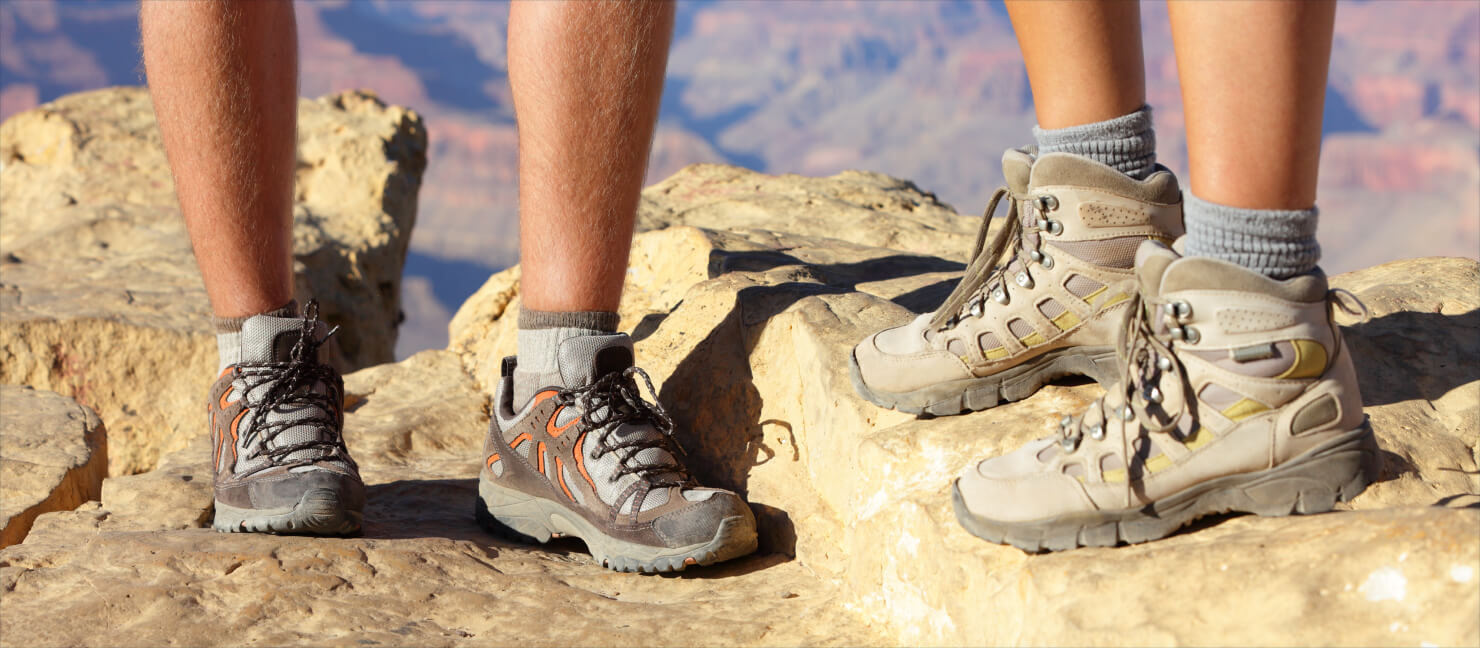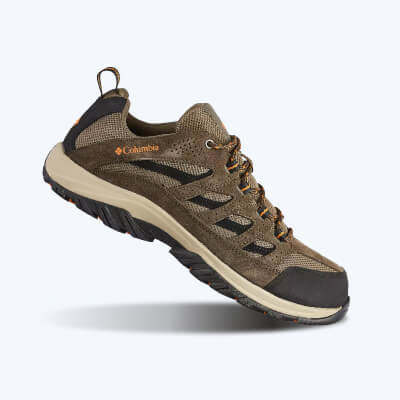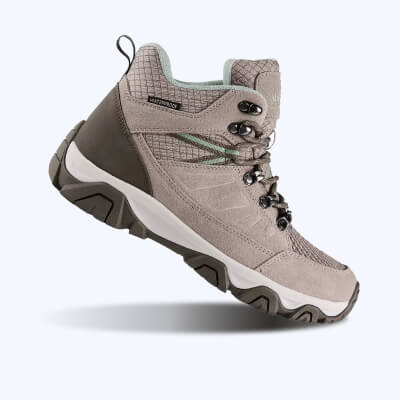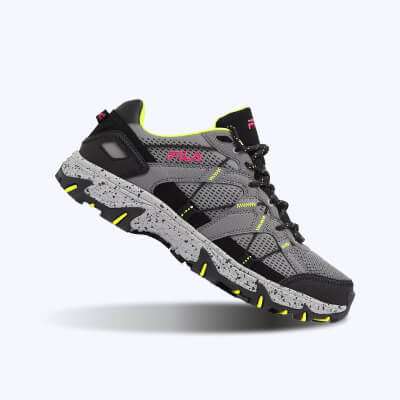Hiking Boots vs Shoes: How to Choose the Perfect Fit

Ready for your next hike but confused about whether you should choose hiking shoes vs hiking boots? Both excel in outdoor adventures and offer unique advantages — as well as some drawbacks. In this guide, you’ll learn all about which hiking footwear is best for you, your intended adventure, and so much more!
Key Takeaways
- Hiking Shoes vs Boots vs Trail Runners: Hiking boots come in low, mid, and high-cut designs. They can tackle challenging terrain in colder climates. Hiking shoes are lightweight and best for well-maintained hiking trails. If you’re looking to jog or run, consider trail runners.
- What Is the Difference Between Hiking Boots vs Shoes? Hiking boots provide added ankle stability, insulation, traction, and water resistance. On the other hand, hiking shoes are more breathable and lightweight. They also have a shorter break-in period compared to hiking boots.
- Should I Wear Hiking Boots or Shoes? When deciding between a hiking shoe vs boot, stick with a sturdy pair of boots for technical trails. For casual day hikes, opt for hiking shoes, which offer less traction and stability.
Hiking Boot or Shoe Considerations
Both hiking shoes and boots offer protection against potential sticks, rocks, and roots on (and off) the trail. Before you buy that heavy-duty pair of boots, think about your general hiking plan and realistic needs. When you’re ready to shop around, keep these considerations in mind:
Comfort and a proper fit are your top priority — no matter which pair you choose. Also, expect and plan for a potentially long break-in period (typically anywhere between 1-4 weeks).
Hiking has its hazards. Hiking boots AND shoes protect your feet as you trek the sometimes unpredictable trail ahead.
Prioritize lightweight pairs. Every ounce you spare your feet equates to more energy gained to explore a bit farther for longer!
Trail comfort doesn’t stop once you buy a pair of hiking boots or shoes. Keep your feet dry with a pair of moisture-wicking hiking socks. Check out Merino wool options.
See how hiking shoes and boots differ across important categories like traction, ankle stability, break-in period, and more. You’ll also find trail running shoes in the table below so you can choose the best pair for your specific trail goals.
| Comparing Hiking Shoes vs Boots vs Trailrunners | |||
|---|---|---|---|
| Category | Hiking Boots | Hiking Shoes | Trail Runners |
| Traction | Excellent on rugged terrain | Good on most trails | Excellent on trails |
| Ankle Stability | Provides strong ankle support | Provides less ankle support | Limited ankle support |
| Break-In Period | Typically longer (1-4 weeks) | Wear right out of the box but may need a few days or weeks to break in | Short, should fit well right out of the box |
| Midsole Protection | Offers more cushioning and protection | Less cushioning and protection | Moderate amount of midsole cushioning |
| Weather | Suitable for various weather conditions | Better for warm and dry weather | Ideal for mild weather, can grip well in muddy terrain |
| Type of Hike | Ideal for longer hikers and challenging terrain | Better for warm and dry weather | Short to moderate hike and/or trail run |
| Support | Offers excellent arch and ankle support | Offers decent arch support | Offers good support |
| Miles | Comfortable for long-distance hikes | Suited for shorter hikes | Good for longer-distance running |
Traction
Whether you're crossing slippery streams or scaling steep slopes, the potential for falling or tripping is a constant risk. Naturally, traction is a staple feature of any good hiking shoes or boots! Knowing where you’ll hike AND the common trail conditions you should expect will help you determine which hiking footwear is best for your exact goals:
Hiking Shoes: Hiking shoes are similar to sneakers. They offer modest traction, and most have a minimal grip on their soles.
Hiking Boots: Hiking boots feature grippy outsoles, which provide excellent traction across a diverse array of terrains. Many hiking boots feature multidirectional lugs on their soles — enhancing their grip and stability on challenging surfaces.
Trail Runners: Many trail runners feature lugs under the heel. This offers increased traction on slippery trails.

Ankle Stability
The amount of ankle stability and/or support you’re looking for will greatly influence your choice between hiking shoes, boots, and trail runners. The amount of support you need often corresponds with the type of hike you plan to undertake (e.g. a short hike, an all-day hike, or a trail run).
Hiking Shoes: Hiking shoes typically offer lower ankle support, making it somewhat easier to roll your ankle. On the flip side, many hikers appreciate hiking shoes' greater freedom of movement and improved ankle mobility.
Hiking Boots: Hiking boots often restrict ankle mobility — a trade-off for superior ankle stability and support. You’ll find them in various styles: low, mid, and high-cut boots.
Trail Runners: Trail runners offer less ankle stability compared to hiking boots. The lower ankle support does make it easier to run on trails.
Break-In Period
Whether you plan a quick day hike or a trekking expedition across the Appalachian Trail, budget at least 1-4 weeks to properly break in your hiking boots or shoes.
Hiking Shoes: Hiking shoes often offer high comfort right out of the box. You might need to wear them a few times for a perfect fit. However, many hikers can find them suitable for quick (though typically NOT immediate) use without getting major blisters or pains.
Hiking Boots: Hiking boots tend to be more rigid and require an extended break-in period. Comfortable socks and a solid break-in plan can help you avoid any major sores, blisters, or pains.
Trail Runners: Similar to walking shoes, trail runners should fit well the first time you wear them. You can start with a few short runs before increasing your mileage.

Midsole Protection
The midsole of your hiking footwear absorbs shock and protects your feet from the rugged terrain.
Hiking Shoes: Hiking shoes typically feature a comfortable midsole with effective shock-absorption properties. However, some may offer less midsole protection against sharp objects like stones and sticks compared to hiking boots.
Hiking Boots:Hiking boots have a substantial, cushioned midsole that shields your feet from potential hazards. Their midsole design offers enhanced protection and support.
Trail Runners: Trail runners protect your feet from sharp rocks on the trail. They also have nylon uppers to prevent twigs from puncturing the fabric.
Weather Conditions
While you may initially plan a hike under clear skies, unexpected rainstorms can leave your feet drenched. Choose the right footwear that offers the most flexibility — depending on what hike or run you take:
Hiking Shoes: Hiking shoes are ideal for warm and dry weather. Many of them feature mesh uppers that can quickly dry if exposed to rain or a stream crossing. While they offer breathability, they may need more insulation in colder or wetter conditions.
Hiking Boots: Hiking boots excel in questionable and more intense weather conditions, (like heavy rain or snow). They usually have a waterproof construction, added insulation, and especially durable materials to keep your feet dry, warm, and safe.
Trail Runners: Trail runners can typically dry rather quickly when wet. However, they are best suited for more mild weather conditions. Most trail runners don’t have a waterproof construction.
Expert Tip:
Apply a waterproof spray to your hiking boots or shoes to improve their water repellency.

Type of Hike
The hiking footwear you choose depends on the type of hike you plan. Choose hiking shoes if you’ll be hiking on a well-maintained trail and hiking boots if you’ll be scaling rocks or crossing particularly risky water crossings. Just looking to run outdoors? Trail runners are your best bet!
Hiking Shoes: Hiking shoes excel on day hikes along well-maintained or more predictable trails. Because of their construction, you can also enjoy more freedom (e.g. faster-paced running) and a more flexible hike.
Hiking Boots: Opt for hiking boots for moderately paced hikes or off-trail excursions that demand grip and traction. Their rugged design and ankle support make them perfect for navigating more challenging landscapes.
Trail Runners: Choose trail runners for shorter hikes and/or runs with very minor elevation and predictable terrain. Avoid wearing your trail runners on completely smooth surfaces, which tend to wear down the tread.
Ankle & Foot Support
You’ll need extra support for a hike than what typical sneakers provide. In that case, see the support difference between hiking shoes vs boots:
Hiking Shoes: Hiking shoes sometimes will not suit varied hiking terrain as well as hiking boots. To enhance foot support, consider adding inserts.
Hiking Boots: Hiking boots offer improved ankle and arch support. However, their increased stiffness and weight can hinder hiking performance.
Trail Runners: Trail runners offer exceptional support and impact resistance.
Miles
For those who hike often, having durable hiking gear is key! Frequent hiking or running wears down any pair of boots or shoes. Every hiker and trail runner should learn the general time they can expect from their footwear:
Hiking Shoes: Hiking shoes typically last around 500 miles. Look for signs like deformation or a floppy structure, which both indicate that it's time for a new pair.
Hiking Boots: Quality hiking boots can endure between 600 and 1,000 miles. A decrease in comfort or worn-down tread means it's time to invest in a new pair.
Trail Runners: Trail runners typically last 300 to 500 miles before you need a new pair. If the tread is worn down, opt for a new pair.
Hiking boots offer stiff, exceptional support and enhanced ankle stability — making them ideal for technical hikes. They perform exceptionally well on challenging trails. They also feature waterproof materials and extra insulation for freezing temperatures. Their often high-cut ankle design does provide ankle support — but at the expense of ankle mobility and flexibility.
On the other hand, hiking shoes are easier to break in and quicker to adapt to. They are the perfect choice for casual day hikes. Most pairs are usually quick to dry should they get wet (either from a stream or a sudden downpour). Hiking shoes are a popular alternative for casual trail running and offer better ankle flexibility — at the expense of improved support and ankle stability.
Hiking Shoes

Hiking shoes are lightweight, breathable, and quick-drying when wet. Most will feature a cushioned midsole and traction on the outsole.
- Ankle Support: Hiking shoes may not provide sufficient ankle support. Hikers often prefer hiking boots for carrying heavy hiking gear.
- Protection: Hiking shoes offer midsole protection from twigs and sharp rocks on the trail. A fortified midsole also aids in shock absorption.
Hiking Boots

Hiking boots provide top-notch ankle support. Manufacturers use taller designs for more insulation and colder weather. You’ll find that most are waterproof and feature padded collars and tongues.
- Construction: Hiking boots are stiffer, making them excellent for snowy terrain. They typically use materials like nylon, synthetics, and leather.
- Traction: Hiking boots come with grippy outsoles to increase traction. You can even add grip studs to your boots for easier hiking on snow and ice.
Trail Runners

Trail runners are perfect for wet or slippery terrain that you need to run on. Most feature mesh uppers and rubber outsoles for added support and reduced impact stress.
- Uses: Hikers use trail runners for races on forest and mountain paths. They offer a more rugged rubber outsole for increased traction.
- Surfaces: Avoid wearing trail runners on hard surfaces like concrete. This can wear down the tread. In those cases, opt for running shoes instead.
Hiking Footwear Recap
So which hiking footwear should you choose? Hiking boots, shoes, and trail runners all have a place on the trail (and in your closet). The most important factors to consider when you plan to purchase a pair include personal comfort preferences, material & features, as well as any budget constraints you may have. Ultimately, the right choice is whatever suits your unique needs and hiking style best.
| Comparing Hiking Footwear Options | ||
|---|---|---|
| Hiking Footwear | Key Features | Best For |
| Hiking Boots | Ankle support, durable materials (often leather), over-the-ankle construction | Rugged terrain, carrying heavy backpacks, longer hikes |
| Hiking Shoes | Lightweight design, suitable for everyday use, ideal for mild weather | Casual hikes, gentle terrain with minimal elevation |
| Trail Runners | Lightweight, breathable, grippy outsole | Comfortable for extended use, trail running on uneven terrain |
Having any combination of hiking shoes, trail runners, and boots can offer you the best flexibility — especially as you take on more challenging trails! Choose hiking shoes on less demanding day hikes. Slip on some hiking boots to tackle rockier terrain. Use trail runners when you want to run on your favorite trail!
Have Fun Out There!
Gearing up for a hike? You’ll find everything you need at Academy! We have a wide selection of hiking boots and hiking shoes. Find the best variety of hiking gear while you're here. Happy trails!

 Gift Cards
Gift Cards Big Fun Deals
Big Fun Deals Hot Deals
Hot Deals Clearance
Clearance

